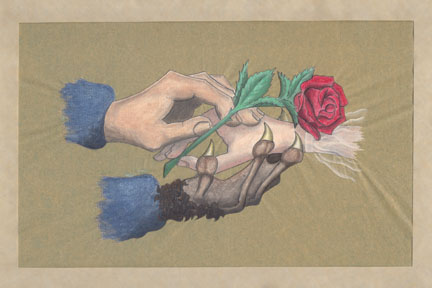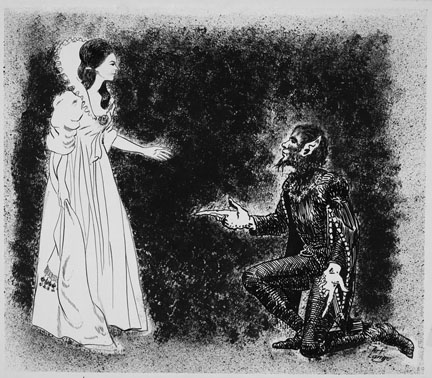
Artwork by Julian R. Pace
Opera in Three Acts
Performance Reviews
“...inspired tunes and imaginative orchestration, seasoned with dramatic instinct...late-French-romantic lushness...the simple, folk-opera style of Beauty’s “Homesick Song”, (and) the last act quartet, provided beautiful contrast...visually as lavish as the score...”
E. Thomas Glasow, OPERA NEWS review of Beauty and the Beast
“...what astonishes is the innate talent of Frank DiGiacomo...Melodic gift is the rarest of gifts for a composer. The ability to write a tune that sounds genuine, that fits the dramatic and musical setting...is something one does not encounter in more than a handful of composers. DiGiacomo has it... and has it in spades”
Henry Fogel, WONO-FM Program Guide review of Beauty and the Beast
“First and foremost, Frank DiGiacomo can write for that greatest of instruments, the human voice. And that is the essence of opera: the glorification of the voice. DiGiacomo employs the familiar idiom of arias, duets, and quartets but the content is genuine and moving...It is not re-heated Puccini. It is new and beautiful...Last night had the excitement of discovery...It’s something very, very special. Bravo, Frank DiGiacomo.”
Larry McGinn, WONO-FM on-air review of Beauty and the Beast
“Memories of childhood...lilting music...an out-of-this-world air...an opera with heart.”
Nevart Apikian, POST STANDARD review of Beauty and the Beast
“...Delightful and charming, warm and touching...a gentle escape of fancy and fantasy.”
Ronald Ranallo, HERALD JOURNAL review of Beauty and the Beast

Illustration by Arthur Lange
Production History
Frank DiGiacomo’s Beauty and the Beast was first performed on May 24 and 25, 1974 at the Regent Theater in Syracuse, New York. Beauty was played by Christine Klemperer, the Beast-Prince was William (Bill) Black, First Sister Gayle Ross, Second Sister Donna Miller and the Father was played by Donald Miller. The production was produced, designed, directed and conducted by Erwin R. Vrooman. Marian Schmidt, assisted by Marian Lillie prepared the choreography.
This production was the first of the composer’s operas to be completely scored and fully staged. Although it was an unknown opera, the public reception was very enthusiastic and gratifying. It was something of a miracle that the production of Beauty and the Beast came into being at all. The dedicated group of artists and friends who brought it into existence provided an energy that was unique and very rare. The enthusiasm was infectious and everyone involved understood that an historic event was taking place – the creation of a new work of art. The challenges of an opera production were almost too much for the resources and capabilities of the committed participants, but it was a labor of love for all and they made it happen.
The MP3 live excerpts presented here are from those performances. These archival recordings are not the studio products you might expect, but they do show the beauty and grace of the piece, despite the vagaries of live performance.
The favorable public response led to a second professional premiere by Opera Theater of Syracuse, now Syracuse Opera, on May 28 and 29, 1976 at the Crouse-Hinds Theater of the Mulroy Civic Center in Syracuse, New York. The performers in that production included Christine Klemperer as Beauty, William (Bill) Black as the Beast-Prince, First Sister Gayle Ross, Second Sister Donna Miller and the Father was played by Richard McCullough. It was conducted by Gary Sheldon, directed by Terry Glaser and choreographed by Anthony Salatino.
Frank DiGiacomo’s Beauty and the Beast is drawn from the classic French fairy tale of Charles Perrault, but the Composer and associate librettist, Julian R. Pace, strengthened the underlying psychological truths which the story illuminates and added several ideas of their own.
Title and Copyright Information
Beauty and the Beast - Opera in Three Acts
Libretto by Frank DiGiacomo and Julian R. Pace
Acknowledgment is made of the use, in whole or in substantial part, of several poems by Walter de la Mare in the libretto of this opera.
They are Bunches of Grapes, Cecil, The Sleeping Beauty, Song, and Down-adown-derry.
They are published in a collection entitled Songs of Childhood reprinted in America by Dover Publications, Inc., in 1968.
© Copyright 1974 Frank DiGiacomo
Revised version © Copyright 1976 Frank DiGiacomo
© Copyright 2010 Frank DiGiacomo
© Copyright 2014 Sing DiGiacomo
All Rights Reserved under applicable law worldwide.
All rights of public, theatrical, radio, television, and film performance, mechanical reproduction
in any form whatsoever, translation of the libretto, of the complete opera or parts thereof
are strictly reserved.
License to perform this work in whole or in part must be secured from Sing DiGiacomo.
Terms will be quoted upon request. Contact singdigiacomo@gmail.com with your request.
Technical Information
Characters in Order of Appearance
Beauty: Soprano
Father: Baritone
First Sister: Soprano
Second Sister: Soprano
Beast/Prince: High Baritone
Children’s Chorus: SA
Adult Chorus: SATB
Corps de Ballet
Orchestration
First and Second Flutes
Oboe
First and Second Clarinets in B flat
Bassoon
Horn in F
First and Second Trumpets in B flat
Trombone
Harp
Piano
First and Second Violins
First and Second Cellos
First and Second String Basses
Percussion Battery - Bass Drum, Chimes, Cymbals, Finger Cymbals, Glockenspiel, Gong, Hand Drum, Snare Drum, Tambourine, Triangle and Woodblock.
Voice Ranges

